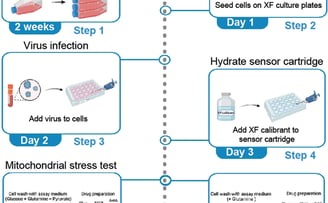A protocol to assess cellular bioenergetics in flavivirus-infected cells
Are you finding a protocol to measure cellular bioenergetics reliably? If so, this step-by-step protocol may be able to help you out!
TRANSCRIPTOMICSZIKA VIRUSCELLULAR BIOENERGETICSMETABOLOMICS


Glycolysis and oxidative phosphorylation are the two major energy yielding metabolic pathways of the cell. However, in the presence of a virus infection, cellular bioenergetics may be affected, which can have detrimental consequences to the cell. For instance, in our recent manuscript published in Cell Reports, we demonstrated that cells infected with pathogenic Zika virus strains can compromise glycolysis and mitochondrial respiration that leads to altered bioenergetics and consequently, cell apoptosis. We further pinpoint a mutation in the Membrane protein (M-F37L) of Zika virus that disrupted cellular bioenergetics, hinting the role of Membrane protein in regulating cellular bioenergetics. See our publication and highlights for more details.
In this detailed protocol, we describe step-by-step procedures to measure various parameters of glycolysis and respiration in virus-infected cells. The important considerations include culturing and propagation of cells and viruses, as well as identifying suitable cell counts, multiplicity of infection and appropriate time-points for measuring cellular bioenergetics. We also highlight the troubleshooting procedures that can be executed to ensure that every experiment will be consistent and reproducible. We hope by sharing these protocols, other researchers can save their precious time in optimising their Seahorse assays, and attract other researchers to collaborate with us to understand the metabolic aspects of viral infections.
This work is done in Duke-NUS Medical School, and published in STAR Protocols. Special thanks to the research assistants for sharing their protocols and the facility manager Yap Lai Lai in NUS (Department of Biochemistry) for guiding us with using the Seahorse analyser.
